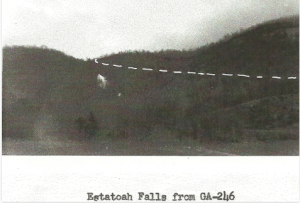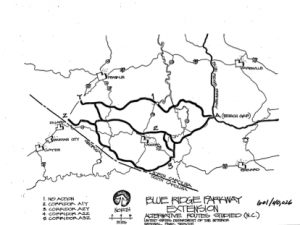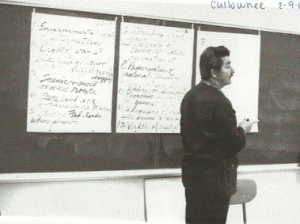The Georgia Extension was a proposed 190-mile addition to the Blue Ridge Parkway from Beech Gap, North Carolina to Marietta, Georgia that failed to materialize due to financial and environmental concerns. While the reasons for abandonment of the project are not explicit in the records reviewed for this project, it is believed that the inaction and ultimate failure to build the Georgia Extension was largely due in part to political agendas, most notably opposition from certain Congressmen.
Negotiations for the extension began on August 12, 1961 when Congressman Roy Taylor brought forth a preliminary proposal to survey potential routes in order to extend the Parkway into Georgia. [1] A major issue when negotiations started was that the extension was originally planned to travel through national forest land.[2] Issues of routing the Parkway remained pertinent throughout the life of the proposed extension. Despite initial tribulations, there seemed to be unquestionable support for the extension from both politicians and citizens alike. According to an article from the Asheville Citizen Times, Georgia representative Phillip Mitchell Landrum said the Georgia Extension would be a, “realization of a dream of many Georgia people.”[3]
The main purpose of extending the already vast Blue Ridge Parkway was to increase visitation by providing a longer, scenic pathway through the Great Smoky Mountains National Park. In order to provide this opportunity, the Parkway addition was planned to extend through, “North Carolina Beech Gap by Whiteside Mountain, Bridal Veil Falls, Cuilasaja Gorge, Estatoah Falls, across the Chattahoochee River and east of Lake Sidney Lanier to a point between Gainesville, Georgia and Atlanta.”[4]
By 1963 the National Park Service, along with the federal Bureau of Public Roads, brought forth studies of prospective routes that would provide the optimum experience along the Georgia Extension. The verdict from the National Park service was to join Interstate 75 and U.S. Route 41, somewhere north of Marietta, Georgia.[5]
 It was not until 1966 that the National Park Service released further development plans for the extension of the Blue Ridge Parkway into Georgia. However, it was at this time that, along with the scenic highway, plans noted that the Georgia Extension would potentially consist of attractions and facilities such as, campgrounds, picnic areas, locations to swim, as well as stops for food and gas.[6]
It was not until 1966 that the National Park Service released further development plans for the extension of the Blue Ridge Parkway into Georgia. However, it was at this time that, along with the scenic highway, plans noted that the Georgia Extension would potentially consist of attractions and facilities such as, campgrounds, picnic areas, locations to swim, as well as stops for food and gas.[6]
By 1966, according to certain members of Congress, the building of the Georgia Extension was supposed to begin within the following two years. However, a price tag was officially given to the project, estimating the addition would cost around $72,778,000 to build.[7] Once Congress stated that it planned to follow through with the building of the Georgia Extension, Appalachian Trail conservationists began publicly opposing the route through which the Blue Ridge Parkway extension was to pass. The main argument of the Appalachian Trail conservationists was that, “the extension would run through forests and disrupt the Appalachian Trail in Georgia.”[8] Despite their concerns, the National Park Service had already taken into consideration the potential interruption and manipulation of the forests and Appalachian Trail. Despite the public debate and the issues being predetermined by the National Park Service, President Lyndon B. Johnson signed the bill to extend the Parkway in September 1967.[9]
The outlook for building the Georgia Extension in 1967 was positive as all political parties and divisions involved appeared to be in favor of the construction. A Marietta Daily Journal article stated that Representative John Davis and Secretary of Agriculture Orville Freeman had no objections to the planned addition of the Blue Ridge Parkway. However, the article also mentioned that, even though the bureau in charge of the budget had no issues with the plan, they warned that if changes were made in throughout the process, the bureau would withdraw their support.[10]
By June of 1967 led by Robert N. McIntyre, Assistant Superintendent of the Blue Ridge Parkway, created a five-year schedule that planned the development and construction of the Georgia Extension .[11] Initiation of this five-year plan began on October 9, 1968 when the House of Representatives and Senate approved a budget of $87,536,000 and granted the Secretary of the Interior the ability to accept land donations on which the extension was to be built.[12] The land that was to be acquired to construct the project was, “federally owned, mostly within national forests…[with] 100 miles are to be acquired by donation only.”[13]
The federal government subdivided the $87.5 million budget as follows:
- Total Estimated Cost: $87,536,000
- Cost of 43-mile Georgia Extension route in North Carolina: $21,054,000
- Cost of 137-mile Georgia Extension route in Georgia: $66,482,000[14]
By 1970, construction plans of the Blue Ridge Parkway were curtailed by Liberty Corporation. The company wanted to develop a new recreational facility called Panthertown. In order to build the Parkway through Panthertown, it was necessary to realign the prospective route of the Georgia Extension. The federal government and National Park Service did not have the money to pay Liberty Corporation in order to follow the extension plans. The impact of businesses such as Liberty Corporation on the planned construction of the Georgia Extension were a main reason the project eventually was derailed.[15]
Between 1970 and 1983, debates and deliberations were held to try to coordinate a strategy in which all businesses, government officials, and environmentalists could agree on a plan to build the Georgia Extension. The hope and excitement that was expressed for the project in 1961 had since faded. On September 11, 1985 the Durham Morning Herald announced that the plan to extend the Blue Ridge Parkway into Georgia was cancelled. The article cited environmental impacts on the Appalachian Trail and surrounding forests to be the top reason for not constructing the extension. In reality, the project failed to materialize mainly because the national debt by the time Ronald Reagan was president made the extension too expensive to construct. Another reason why the project was not built were “private interest” groups such as Liberty Corp. that were manipulating the project in order to comply with the corporation’s personal preferences. Ultimately, the United States government did not have enough money to buy right-of-way land that belonged to big corporations, so companies were able to dictate later versions of the extension plans.[16]
[1] Public Law 87-135, 87th Congress H.R. 6067, August 10,1961. Blue Ridge Parkway Archives, Asheville, NC.
[2]“Extension of Parkway Favored,” Asheville Citizen-Times, June 23, 1961 (accessed November 10, 2013).
[3]“Extension of Parkway Favored,” Asheville Citizen-Times, June 23, 1961 (accessed November 10, 2013).
[4]“Extension of Parkway Favored,” Asheville Citizen-Times, June 23, 1961 (accessed November 10, 2013).
[5] Ian Firth, Ian. “Blue Ridge Parkway Virginia and North Carolina: Historic Resource Study.” draft report, Blue Ridge Parkway and University of Georgia, 2005.
[6] NPS, Department of the Interior, Last modified 13 January, 1966. Accessed November 12, 2013. <a href=”https://www.dropbox.com/sh/t6scxfr0jttyyot/IR2OfIfhVx/Georgia Extension/BLRI_601_3109_[184238].pdf”>Link</a>
[7]“Discussions Open Today On 190-Mile Extension to Blue Ridge Parkway,” Asheville Citizen- Times, December 11, 1966 (accessed November 12, 2013).
[8] Firth, “Blue Ridge Parkway Virginia and North Carolina: Historic Resource Study.”
[9] Firth, “Blue Ridge Parkway Virginia and North Carolina: Historic Resource Study.”
[10] “Reports Favorable On Blue Ridge Parkway,” The Marietta Daily Journal, May 30, 1967, Blue Ridge Parkway Archives, Asheville, NC.
[11] Robert McIntyre, “Development Schedule: North Carolina & Georgia Extension of the Blue Ridge Parkway,” July 6, 1967, Blue Ridge Parkway Archives, Asheville, NC.
[12]“Public Law 90-555-Oct.9,1968.” Office of the Law Revision Counsel United States Code. Link (accessed November 10, 2013).
[13]“Parkway Extension is Approved., Asheville Citizen-Times, January 25, 1968 (accessed November 12, 2013).
[14]“Parkway Bill Signed.” Asheville Citizen-Times, October 11, 1968 (accessed November 12, 2013).
[15] “Panthertown Development Concept Plan: Blue Ridge Parkway Extension” National Park Service, 1970, Blue Ridge Parkway Archives, Asheville, NC.
[16] “Officials Say Parkway Will Not Be Extended,” Durham Morning Herald, September 11, 1985, North Carolina Collection, Durham County Library, Durham, NC.





